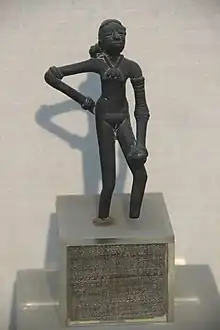Folk dances of Sindh
Folk dances of Sindh (Sindhi: سنڌ جا لوڪ ناچ) are the traditional dances of the Sindhi people, which are indigenous to Sindh region which is now in Pakistan. These dances are performed at various events including marriages, ceremonies, special occasions, on birth of a child and for cultural purposes.
History
Dances in early-medieval Sindh had great prominence which attributed to social and religious life, the scriptures from Mohenjo Daro have proved this fact. The dancing girl from Mohen jo Daro Sambara is quite famous.[1]

Overview
Dances of Sindh include the famous Ho-Jamalo and Dhammal.[2] Common dances include Jhumar/Jhumir (Different from Jhumar dance of South Punjab), Kafelo, Dandio, Talli and Jhamelo[3][4] however none of these have survived as much as Ho-Jamalo, Jhumir and dhammal.[5] In marriages and on other occasions, a special type of song is produced these are known as Ladas/Sehra/Geech and these are sung to celebrate the occasion of marriage, birth and on other special occasions, these are mostly performed by women.
Dances
Some of popular dances include:
- Jamalo: the notable Sindhi dance which is celebrated by Sindhis across the world.
- Jhumar/Jhumir: A dance performed by women and men while singing the lada/sehra/geech (folk wedding songs) on weddings and on special occasions. Relatives and friends would shower money on performers called (ghor) also exchange money garlands.[3]
- Chej[6][7] Although Chej has seen decline in Sindh but it remains popular among Sindhi Hindus and diaspora, Chej is only performed by men. The music is played on sharnai and dholak.[8]
- Bhagat: is a dance performed by professionals to entertain visiting people. The performance usually started at night and lasted till early hours of morning. Only men were allowed to perform the bhagat. Two or more performers interacted to weave folktales in song. The lead singer, called the bhagat would be dressed in jamo (a long coat), pagadi (headgear), chher (anklets) and kundal (earrings). The backup singers were usually dressed up as a women and were addressed by the bhagat by female names. The bhagat was a hugely popular form of entertainment during festivals, marriages and fairs held in mandirs and dargahs.[9][8]
 Bronze "Dancing Girl," Mohenjo-daro, c. 2500 BC
Bronze "Dancing Girl," Mohenjo-daro, c. 2500 BC - Dhamaal:[4] is a mystical dance mainly performed by faqirs, dervishs, sufi saints and devotees. It is characterized by religious fervor. Nagaro, Nobat, gharyal etc provide the beat and tempo for the dance.[3]
- Doka/Dandio: Dance performed using sticks.
- Charuri: A folk dance performed using metal pots in circle, this folk dance is performed in thar.
- Muhana Dance: A dance performed by fishermen and fisherwomen of Sindh.
- Rasudo: Dance of nangarparker while singing a folk rasuda songs.
- Matiku: one of folk dance of thar region of Sindh.
References
- Kalhoro, Zulfiqar Ali (2021-06-17). "Depictions of the Dance of Leela in Sindhi Tombs". The Friday Times - Naya Daur. Retrieved 2023-01-09.
- "An Introduction To Sindhi Dance And Music". Sindhi Khazana. Retrieved 9 January 2023.
- Reejhsinghani, Aroona (2004). Essential Sindhi Cookbook. Penguin Books India. ISBN 978-0-14-303201-4.
- Nettl, Bruno; Arnold, Alison; Stone, Ruth M. (1998). The Garland Encyclopedia of World Music: South Asia : the Indian subcontinent. p. 754. ISBN 9780824049461.
{{cite book}}:|work=ignored (help) - Reejhsinghani, Aroona (2004). Essential Sindhi Culturebook. Penguin Books India. ISBN 978-0-14-303201-4.
- "Sindhi Folk Dance Chhej - The Sindhu World Dance of Unity: Sindhi Group Dance: Cheti Chand: Bahrana: Jhulelal". thesindhuworld.com. 2021-04-09. Retrieved 2023-01-09.
- Advani, Mira Govind (1997). A Saga of Trials & Triumphs of Sindhis, 1947-1997. Indira Ghansham Mirchandani Service Centre. p. 33.
All the way people dance and sing as the ritual is called. The dance is a Sindhi folk dance also called Chej.
- "Culture". www.jhulelal.com. Retrieved 2023-01-09.
- Reejhsinghani, Aroona (2004). Essential Sindhi Cookbook. Penguin Books India. ISBN 978-0-14-303201-4.